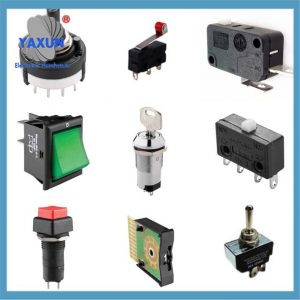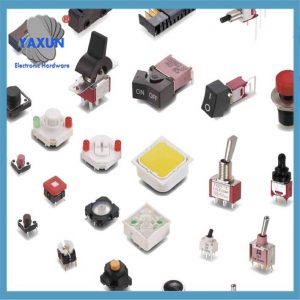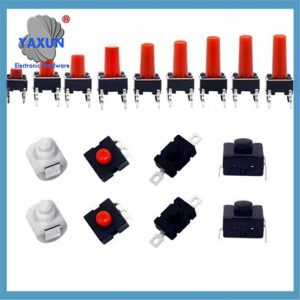電子スイッチで, “sp” のために “単一極,” “DP” のために “ダブルポール,” “st” のために “シングルスロー,” そして “dt” のために “ダブルスロー”; スイッチが制御できる独立回路の数を基本的に説明します (“ポール”) そして、それを切り替えることができるポジションの数 (“投げる”) 単一のスイッチメカニズム内.
 Know the Four Fundamental Types of Electrical Switches Used in Industrial Applications |
 さまざまな種類のスイッチとそのアプリケーションについて知ってください |
 Electronic Tactile Switch Self Locking Switch, Dc 260v 1.5 A Tactile Tact Switch |
Explanation:
単一極 (sp): A switch with only one circuit that can be controlled by the switch action.
ダブルポール (DP): A switch that can control two separate circuits simultaneously.
シングルスロー (st): A switch with only one position, meaning it can either be “on” または “off”.
ダブルスロー (dt): A switch with two positions, allowing it to switch between two different circuits.
Common Switch Combinations:
SPST (Single Pole Single Throw): A basic on/off switch, controlling one circuit with only one position.
SPDT (Single Pole Double Throw): A switch that can connect a single input to either of two different outputs.
DPST (Double Pole Single Throw): A switch that turns two separate circuits on or off together.
DPDT (Double Pole Double Throw): A switch that can independently switch between two different circuits on each of its two poles.

SPDT, DPDT, & 3PDT Switches Differences & Uses
When customers ask us about electronic switches such as button switches and rocker switches. We often ask customers whether they want SPST, SPDT, DPST, DPDT or 3PST, 3PDT. This involves the concepts of extreme numbers and throwing.
SP and DP refer to single pole and double pole respectively, ST and DT refer to single throw and double throw respectively.
The number of poles refers to the number of circuits controlled by the switch: an SP switch only controls one circuit. A DP switch controls two independent circuits (like two identical switches mechanically connected). Don’t confuse “pole” with “terminal”. 例えば, a DPST switch has four terminals, but it is a DP, not a 4P switch.
Throw refers to the extreme position of the actuator: the ST switch closes the circuit in only one position. Another position for the handle is closed. The DT switch closes the circuit in the Up position and Down position (On-On). DT switches can also have a center position (usually On-Off-On).

What are Poles and Throws – SPST, SPDT, DPST, DPDT Switches
Single pole/throw and double pole/throw switches are by far the most common switches, but triple and quadruple configurations are also available. They are usually represented as 3PST, 3PDT, 4PDT, 等.
Functional differences of SP, DP, st, and DT
電子スイッチで, sp, DP, st, and DT refer to the number of circuits and positions a switch can control:
sp: Single pole, which means the switch controls one electrical circuit
DP: Double pole, which means the switch controls two electrical circuits
st: Single throw, which means the switch has two positions, such as on and off
dt: Double throw, which means the switch has three positions, such as on, off, and on
The most common types of switches are:
SPST: Single pole single throw, which has two terminals and is ideal for on-off applications
SPDT: Single pole double throw, which has three terminals
DPST: Double pole single throw, which has four terminals
DPDT: Double pole double throw, which has six terminals
A switch’s poles and throws define its internal circuit structure and contact form.

How to Choose an Electrical Switch
SP and DP refer to single pole and double pole, ST and DT refer to single throw and double throw.
The number of poles refers to the number of circuits the switch controls: SP switches control only one circuit. DP switches control two separate circuits (and act like two identical switches mechanically connected). Don’t confuse “poles” with “terminals.” 例えば, a DPST switch has four terminals, but it’s a DP, not a 4P switch.
The throws refer to the extreme positions of the actuator: ST switches close the circuit in only one position. The other position of the handle is Off. DT switches close the circuit in the Up position and the Down position (On-On). DT switches can also have a center position (usually On-Off-On).
SP/Throw and DP/Throw switches are by far the most common switches, but triple and quadruple configurations are also available. They are often denoted as 3PST, 3PDT, 4PDT, 等.
 English
English العربية
العربية bosanski jezik
bosanski jezik Български
Български Català
Català 粤语
粤语 中文(漢字)
中文(漢字) Hrvatski
Hrvatski Čeština
Čeština Dansk
Dansk Nederlands
Nederlands Eesti keel
Eesti keel Suomi
Suomi Français
Français Deutsch
Deutsch Ελληνικά
Ελληνικά עברית
עברית Magyar
Magyar Italiano
Italiano 日本語
日本語 한국어
한국어 Latviešu valoda
Latviešu valoda Bahasa Melayu
Bahasa Melayu Norsk
Norsk پارسی
پارسی Polski
Polski Português
Português Română
Română Русский
Русский Cрпски језик
Cрпски језик Slovenčina
Slovenčina Slovenščina
Slovenščina Español
Español Svenska
Svenska தமிழ்
தமிழ் ภาษาไทย
ภาษาไทย Tiếng Việt
Tiếng Việt
